The Cessna 208B Caravan
It seems I've got time for another post....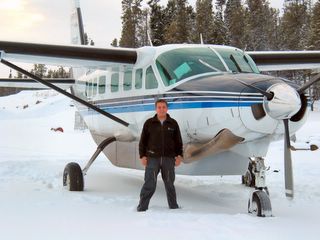
Shawn and The Caravan 
In September of 2004, I was awarded a bid to become a pilot on the Cessna 208B Grand Caravan. The Caravan is one if the workhorses of bush aviation. Capable of carrying a pilot and 9 passenger, or 3400lbs of freight into the shortest and nastiest of airstrips, it's very popular in the sparsely settled areas of Northern Canada, and all over the world. It's sales exceed 1000. In aviation terms, that's pretty popular. Not only very strong outside, it was very strong inside as well, boosting a very well equipped panel making it capable of Single Pilot, IFR operations.
In order for myself, and Skyward, to take full advantage of the 208's single pilot capabilities, I was required to take a one week groundschool and simulator course at the Pan-Am flight training facility in Memphis, Tennessee. Yes, I went to Graceland, it cost $25 for the tour, but is pretty neat. I also recommend checking out Beale Street, very, very cool. The most interesting thing about the Caravan training in Memphis was simulator. It was a Level D Simulator, meaning in the United States, I could have done my flight test in this machine. The panel was exactly the same as the panel in the real Caravan, all the switches and levers in the exact same spots, and the screen spanned 180 degrees. They could set up anything and everything on the sim. Day, night, rain, and snow. They could simulate the vibration of the prop when ice is forming on it. The whole experience was very cool. However, although the movement of the sim was pretty much bang on, it still felt a little strange to me. I was happy to come back to Canada and fly the real thing. I received my PPC on the Caravan on October 27th, 2004.
The Caravan's history starts in the 1980's when it was designed. The certification of the aircraft came in October of 1984. Right off the get go, FedEx has been closely involved with the development. Used as a feeder aircraft, Fedex currently operates 10 208A's and 246 208B's. Since it's inception, there have been many variations of the Caravan. Currently, Cessna offers a Freight only version, A combi version, an airline version, and a float version. Also, may Caravans have been re-equipped in with an executive interior. Skyward flies the Combi configuration, allowing for maximum use with many different mission types. We can take 9 passengers and still have room for cargo in the back shelf and pods. In true "combi" style, we can take 4 seats out, allowing for 5 passengers all down one side, and fill the other side with cargo. We are also able to take all the seats out and fill it right up with cargo, allowing 3400 lbs behind the pilot. Skyward also has a bulk fuel system which includes two large tanks that sit in the cabin and hold roughly 1400 litres of fuel.
The Cessna 208B Grand Caravan is hoisted into the air by one single Pratt and Whitney PT6A-114A turbine engine attached to a perpetually beaten 3 bladed, constant speed, full reversing propeller, manufactured either by McCauley or Hartzell. The trustworthy PT6 engine produces an impressive 675 Shaft Horsepower. When planning we used a block airspeed of 150KTAS and a fuel burn of 360 pounds per hour. Capable of taking on 2224 pounds of Jet fuel, the Caravan has an endurance of roughly 6 hours and covers a range of 900 NM. The panel is without a doubt the best equipped I've yet to sit behind. Two VHF radios, two VORs, 2 ADF's, one KLN89B GPS, a radar altimeter, weather radar (hence the big ugly pod on the right wing), RMI, HSI, and a 3 axis autopilot. To top things off, the KLN89B is wired into the HSI, making navigation based on the GPS very, very easy. The KLN89B is approved for IFR navigation, however, Skyward does not have an approved program in place to allow us to use the GPS in that role. Although the Caravan is certified for operations up to 25,000', operations at the altitude would require an oxygen system that the planes I fly do not have, nor do I feel the need to fly that high. Much like the Bandit, our operations take place at 13,000' and below. The Caravan also certified to fly into known icing conditions, sporting a modest deicing/anti-icing package including boots, prop heat, windshield heat, stall warning and pitot/static heat. Given the shape of the Caravan, it's flight into icing is somewhat limited and has been the source of debate in the past. Although my experience with it in ice is somewhat limited, I can say it can handle some ice, however, I wouldn't want to be hanging around in it. One of the things we then must consider before shooting a non-precision approach is whether we are able to descend through the layer of cloud overhead the airport, conduct an approach, a missed approach, and climb back out of the layer. I do know of one such occasion were a pilot was not able to do so and, after only being able to climb to around 2000' AGL, had to return to the airport with landing as the only option.
The Caravan is most definitely the work horse at Skyward. We use it for scheduled flights, charters, cargo, and many special missions. Very capable off-strip performance allows us to use the 'van' in remote locations such as nasty lodge strips and nastier esker work in the Arctic, supporting mining operations and exploration. Though I've yet to find myself anyplace too exciting, I have heard stories and seen photos of the caravan operating in and out of locations where you would never expect and aircraft to go. It's a truly amazing airplane.
Something the Caravan has introduced me to is Single Pilot, IFR flying. Most aircraft operating IFR require two pilots, due to the work load in the cockpit (some larger, older aircraft require 3). However, there are aircraft out there designed specifically for IFR operations with one pilot. The Caravan is one of these aircraft. Some people believe that flying Single pilot IFR is extremely risky. Given that IFR flying introduces a higher workload and requires extra vigilance, another brain and set of hands beside you certainly makes the job easier. However, if the aircraft is properly equipped with a good autopilot (a legal requirement to fly single pilot IFR), and you adopt certain practices, the risk is greatly reduced. It's so far been my experience that a single pilot IFR operation is just as safe as a two crew operation. The most important ingredients in both situations is knowledge, training, and sticking to procedures. If you're are flying single pilot IFR and looking for some tricks to make your life easier, a quick google search turns up many articles with pointers.
For further cool Caravan tidbits, you can check out Caravan Pilots, or check out some Caravan photo's on Airliners.net.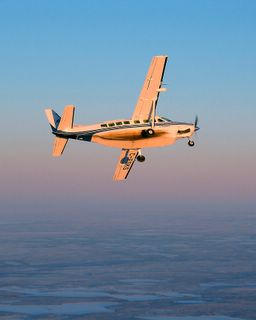
SKS enroute from Brochet 

SKX on the way to Brochet 
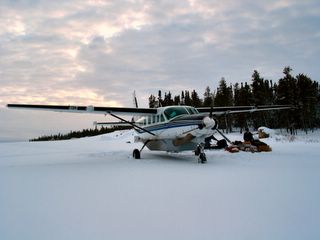
SKX at Egenelf Lake Lodge 
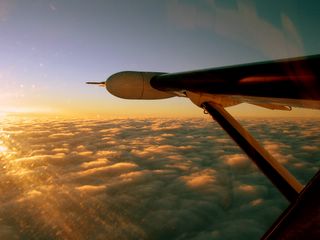
Sunset over the clouds 
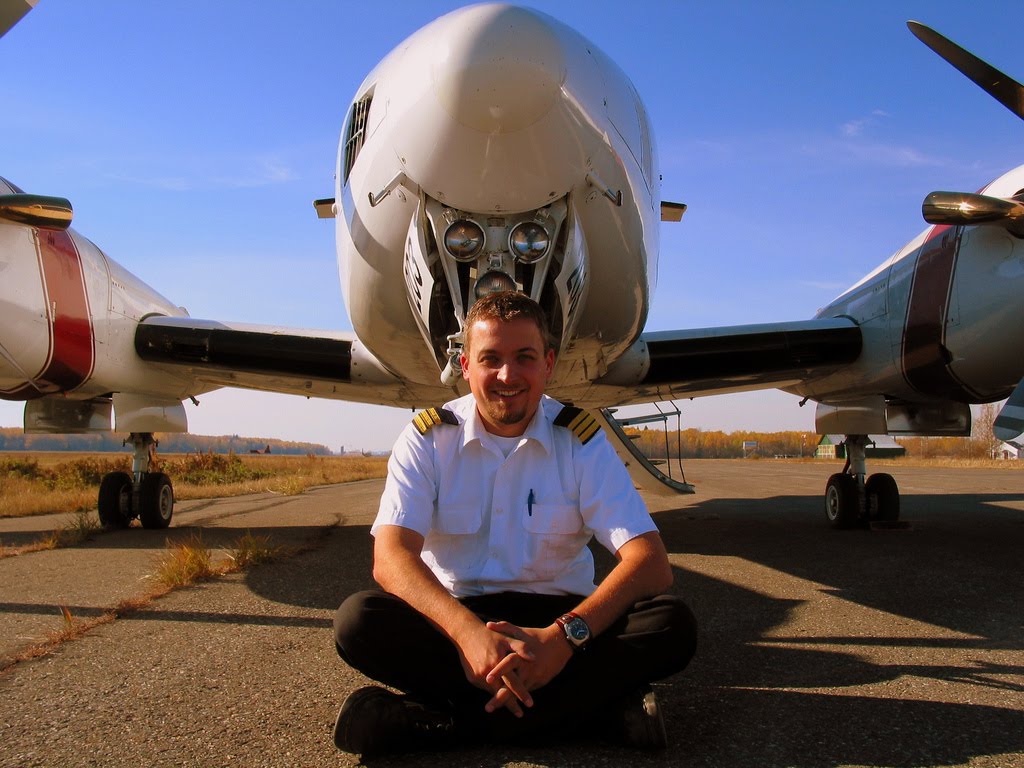



10 comments:
An autopilot is not required to fly single-pilot IFR on a private flight, even in a commercially-registered (light) plane.
I am sure he is reffering to Commercial operations. A commercialy registered light plane ? Maybe if the CEO takes it out for a rip for pleasure but not a revenue flight.
I was refering to aircraft operating under Section 7 of the CARs. However, giving it some thought, if those of us flying single pilot IFR on a regular basis are required, and the feel the need, to have an autopilot, how safe would it be for some weekend warrior to be out there tooling around in the mist without one?
Great post, Shawn.
Not too many private owners in Canada tooling around in Caravans. I've done single pilot IFR privately in non-autopilot-equipped C172s. It's a handful in IMC. I'm going to add something to my personal list of requirements for single-pilot IFR. For shorter trips I won't demand an autopilot, but definitely the boom mike with yoke-mounted PTT, lighted chart holder, and a panel-mounted clock. Timing approaches with your wristwatch is too much like duck and cat IFR.
I can see doing a short trip or two without an autopilot. I found though, that after a full day of IFR, even with an autopilot, I'm exhausted. So if I were expected to do single pilot IFR all day long, the autopilot is most definetly something I would look for.
That being said. I think it's important to hand fly the approach on a regular basis. Using the autopilot on a regular basis is a great way to lose a good set of hands and feet.
As for the clock, the ADFs we have have a timer that counts up and can be set to count down. I used it all the time, very handy.
I have almost 50 hours actual IMC now in my Warrior, all without an AP (that includes moderate turbulence, night, low approaches, and a touch of icing).
Hand flying in IMC really isn't a big deal in a draggy plane like a Warrior. For the first 15 minutes or so, my heading will be a bit sloppy (frequent 5-10 degree corrections), then it just becomes automatic, like flying VFR, and I relax and can carry on conversations with passengers, read the CFS, and generally think about and do other things, though I cannot get away with fixating on a chart for too long.
It's a whole different story, of course, in a retract or a slick plane. Those can accelerate quickly into a spiral (ever notice that all partial-panel accidents for IFR pilots in IMC have been in retracts? I have yet to find a single one in a fixed-gear plane). I'm not sure I'd be comfortable hand-flying a Mooney SP-IFR without an autopilot.
The auto pilot is certainly a plus, especially if you're IMC for long periods of time, but i really depend on a good gps and the marker beacons myself
The auto pilot is certainly a plus, especially if you're IMC for long periods of time, but i really depend on a good gps and the marker beacons myself
A good GPS makes a world of difference. Most of my experiance has been with a KLN89B or 90B. The Navajo I just started flying has a Garmin 530. It's like a whole new wrold has opened up in regards to GPS
First I just want to apologize for my english, is getting rusty. I was hired last week to fly the Caravan in Nicaragua, Central America. That´s why I found very interesting your post Shawn. Greetings to all my fellow pilots in Canada... Specially those flying at Harv´s Air in Steinbach, Manitoba. - Aerodiaz -
Post a Comment